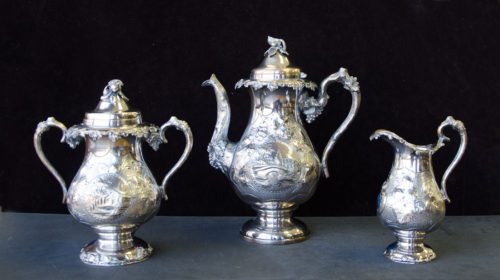Created by Heinrich Lange as a wedding gift for his daughter Carolina, the silver coffee service depicts the original Moravian Church in Newfoundland where she married Gustav Schubert in 1852. Heinrich Lange was a pewterer and silversmith living in Switzerland with his wife, Anna, and their four children when, on the advice of his physician, he and Anna decided to immigrate to America. They were among the first families to make their home in the village of Newfoundland and were early members of the Hopedale Moravian Church, a mission church built in 1837. Carolina’s daughter Emma Schubert Brister (1855–1937) recounted the story of her grandparents’ arrival to their new home in her 1936 memoir, Incidents. Below is an excerpt from her book, in which she describes the lavish ornamentation on the coffee set.
A change of air! Such a casual pronouncement and such far reaching results. It was to my grandfather, Heinrich W. Lange, that the physician gave this advice. Grandfather was a pewterer and conducted a lucrative business in Switzerland. Not only were his designs beautiful, but so perfectly was his pewter alloyed (from his own formula) that pieces in the possession of his descendants, could have been no more beautiful at their creation, than they are now—after a century of use.
My grandparents decided to seek the change of air in the New World. This decision was reached in the through the influence of a friend who had come to America and purchased a farm in the Pocono Mountains of Pennsylvania. What an undertaking that was! What heartaches must have been endured! Grandfather, Grandmother and their family of children, including my mother, Carolina, who was seventeen, embarking for America, leaving friends and kindred, the business and the homeland behind. I am glad their choice for a new home was in the Pocono Mountains, for the beauties of that region must surely have assuaged the pangs of homesickness. The farm they purchased was located eight miles from the railroad station in Gouldsboro.
Vehicles drawn by horses and oxen conveyed the family from the station to the farm. In my own childhood, to be met with a cart drawn by oxen and filled with hay was the grand finale to the journey. Into this would the youth of the party clamber, making merry the slow journey, with the singing of many songs. Horses and oxen have now been replaced with motor vehicles, but otherwise, few changes have taken place.
It was here that Henry and Anna made their new home, but they did not continue strangers in a strange land for long. Soon friendships were formed and hospitality extended and accepted. An invitation from friends in Philadelphia, requesting that my mother come for a visit was accepted with pleasure. It proved to be a momentous occasion, for visiting in the same household were Gustav and William Schubert. They were two talented musicians, born in Saxony, and like the Lange family, had emigrated to America and were living in New York. I am sure the fact that they had been born and raised in the Old World was the first bond between them, which later welded their lives together. Gustave immediately fell in love with my mother. This love was reciprocated and their romance was consummated in a marriage which was solemnized in the little Moravian Church in Newfoundland on March 21, 1852.
The original church wherein my parents were wed was immortalized by my grandfather. With his own hands he fashioned a beautiful coffee service for a wedding gift for his daughter. The ornamentation on this service was a charming scene, depicting this church and a nearby stream over which was suspended a bridge—a bridge traversed many times by the members of the Lange family. Thus did the wedding gift serve a three-fold purpose: being a permanent record of his skill, a reproduction of the original church, and a lasting memento of a happy occasion.
The Lange coffee set is in the permanent collection of a museum in Bethlehem and is, on special occasions, loaned to the Greene-Dreher Historical Society for display at Peggy Bancroft Hall.
